How Extensible Messaging Across Channels Can Support Flexible, Highly Relevant Marketing Experiences
Published on July 07, 2023/Last edited on July 07, 2023/10 min read
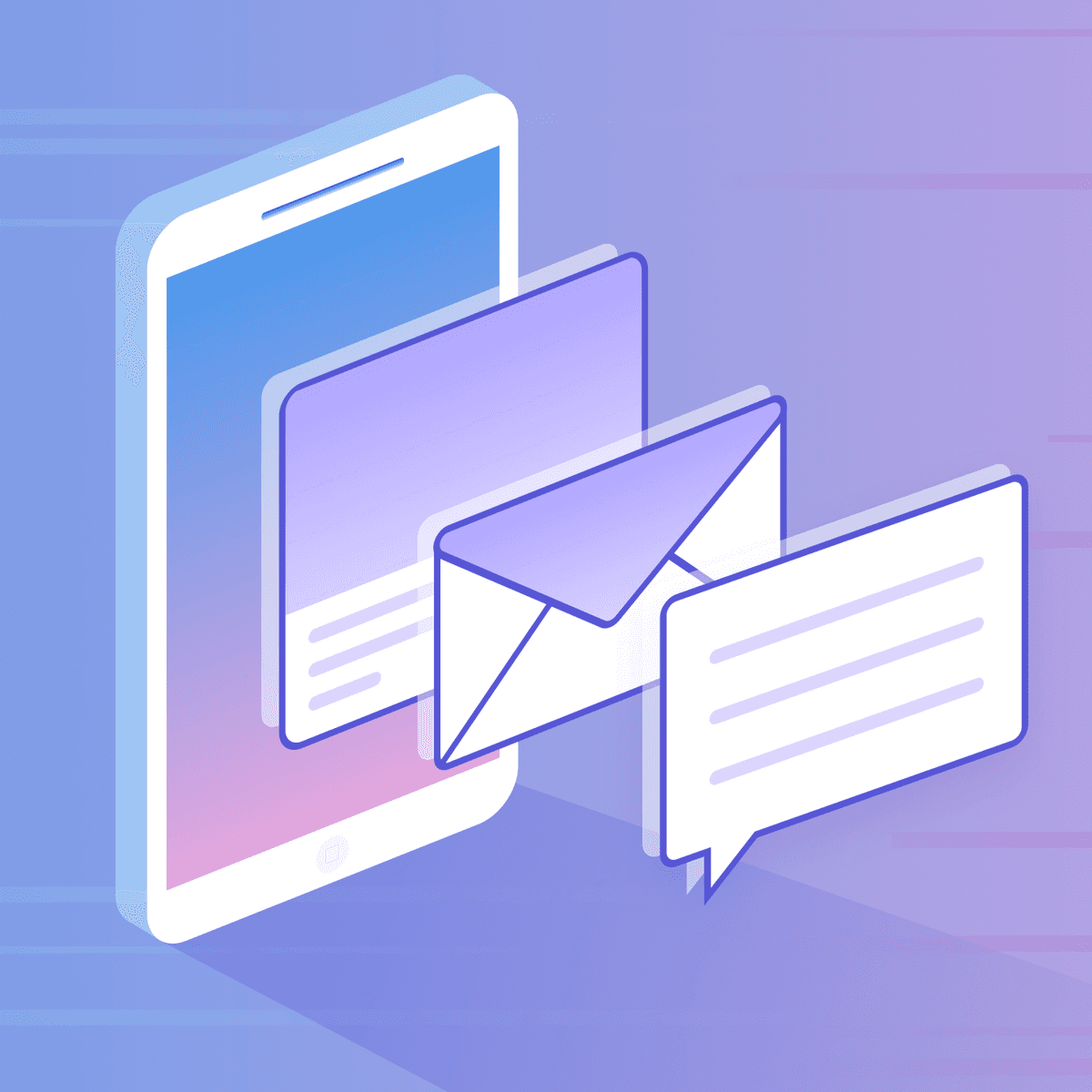

David Bielik
To effectively engage consumers, marketers need marketing technologies that are powerful, but also flexible. Providing that flexibility in your customer engagement efforts is where the concept of “extensibility” comes into play. Extensibility describes a set of software design principles that make it possible for a given system to stretch its intended capabilities into new environments or to support new use cases—and to do so without requiring major modifications or impacting quality or stability. When it comes to customer engagement, extensible technologies can represent a bet on the future, making it possible for brands to rapidly meet evolving needs or execute on emerging use cases without requiring a massive tech overhaul.
That’s where Braze comes in. During the rise of mobile, we saw the need for native support of messaging across channels that would make it possible for brands to reach their users effectively in a multi-channel world—and in the same spirit, we’ve made a point of supporting extensibility when it comes to our messaging offering. To dig deeper into how this approach helps brands leverage the Braze platform in new and inventive ways that drive results, let’s take a look at the two key places Braze is built to support messaging extensibility: Extensible messaging channels and extensible messaging features.
Extensible Messaging Channels Supported By Braze
Mobile In-App Messages
In-app messages, made possible by the popularity of smartphones, give marketers the ability to directly speak to consumers when they’re active on a brand’s mobile app. That makes them a powerful way to communicate with users about everything from onboarding and product updates to promotions and recommendations, and all of these messages can be easily enriched with personalization and delivered in a number of different formats (e.g. slide-ups, modals, and full screen messages). In sum, in-app messages enable personalized experiences for active app users—the marketer’s dream combo.
Because mobile in-app messages exist exclusively within a given company’s mobile app, it’s possible to create the perception that they’re part of the native app experience by customizing the look, feel, and behavior associated with these communications, resulting in a more seamless, compelling experience. For some brands, that might means simply matching the colors, typeface and other design elements within an in-app message to the app surrounding it, but Braze support for custom handling and advanced customization of mobile in-app messages makes it possible for brands to support native-feeling experiences that extend beyond what’s possible for traditional messages.
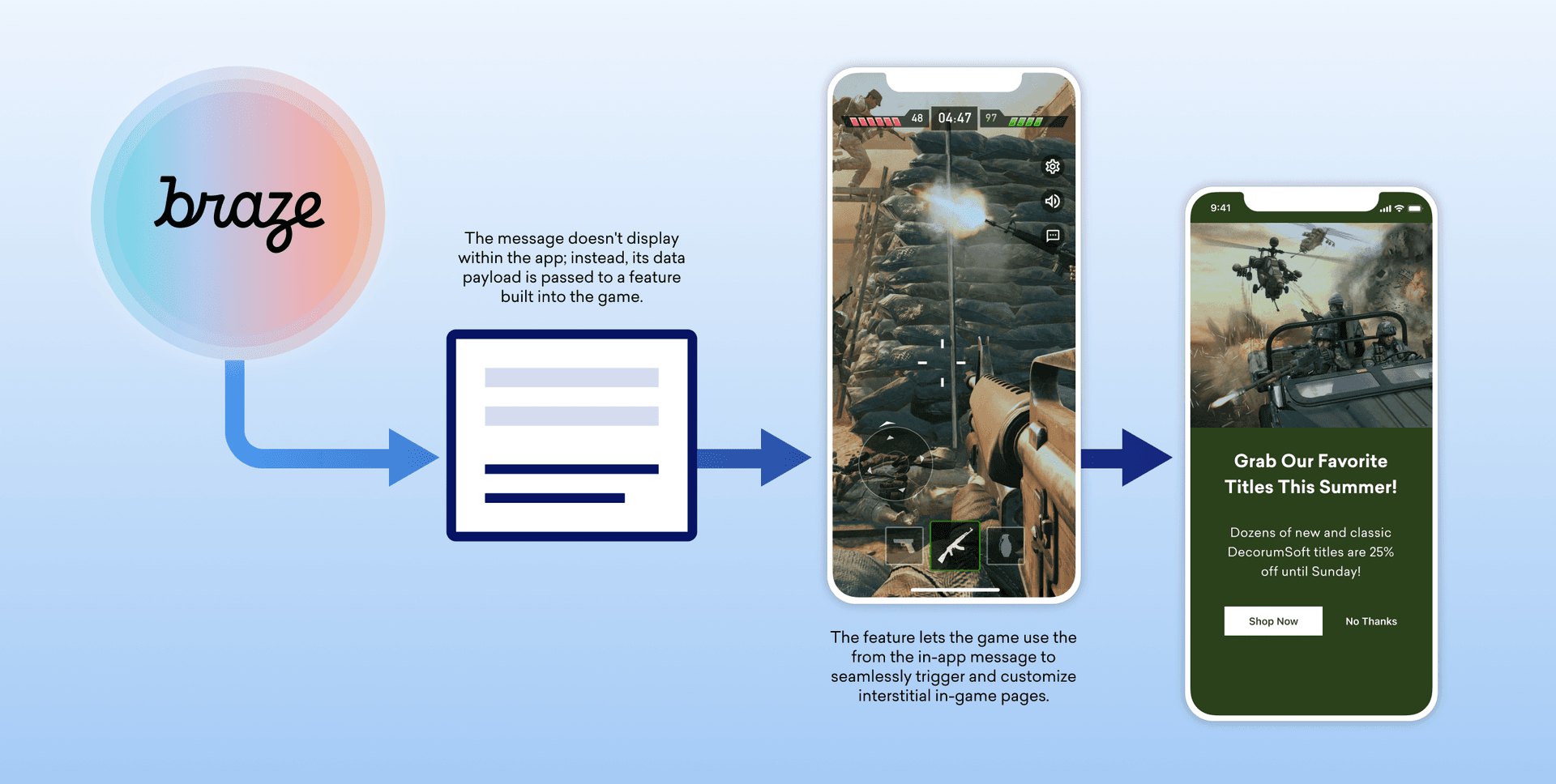
What does that look like in practice? One of our customers, a leading gaming brand, took advantage of the extensibility of our mobile in-app messages to successfully power interstitial, standalone pages within their mobile games. Under this approach, when users move between levels of a game, they receive a custom page experience that isn’t technically an in-app message, but instead uses Braze in-app messages to power and customize the on-page experience. The company makes it all happen by leveraging the Braze mobile SDK that they’ve installed in their apps to hand over the data payload associated with the message directly to the game—and to do it without actually loading or displaying the messages itself. Instead, the data is consumed by a feature they’ve built that renders these interstitial pages and customizes them based on that payload.
This approach makes it possible to quickly stand up rich experiences inside games using their Braze-powered messaging capabilities, as opposed to continually making product changes that would have required them to officially update the apps. And it’s just the tip of the iceberg when it comes to what’s possible with custom handling and advanced customization of these messages.
Mobile Content Cards
This powerful, in-product messaging channel was developed by Braze back in 2019 to allow marketers to serve up carefully targeted, dynamic streams of rich content for their users without interrupting their experiences. Like in-app messages, Content Cards are another great way to share meaningful but unobtrusive content within the mobile app experience. In addition to the sorts of styling and visual customization that in-app messages can also support, Content Cards can also be customized when it comes to the experience they provide, allowing brands to leverage these cards as an ongoing newsfeed-style flow, a messaging inbox, and much more.

To see what the extensibility of mobile Content Cards makes possible, consider the “Pride Perseveres'' campaign from leading LGBTQ+ social network Grindr. The company needed to take its annual Pride month celebration online at the height of COVID-19 and to do it on short notice. By taking advantage of the advanced customization that Content Cards make possible (in this case, via key-value pairs), they were able to power what appeared to be an innovative new UI, but without the backend lift it would have taken to actually build out this experience within their product. Plus, Content Cards’ flexibility allowed this calendar to accommodate everything from live performances to merchandise sales, tackling a variety of customer and brand needs within the same platform and driving a 34% spike in daily active user (DAU) engagement.
Because they’re designed to support advanced customization, Content Cards can be seamlessly integrated into the native app experience in innovative ways, including the sorts of use cases that Grindr leveraged. Content Cards can provide marketers with the ability to power rich, product-like experiences without the kind of lead time, engineering support, or app store updates that might otherwise be required.
Extensible Messaging Features Supported By Braze
Connected Content
The rise of mobile created a customer engagement landscape where consumers expect highly relevant in-the-moment digital experiences from the brands they care about. To make it possible for brands to meet that need, in 2015 Braze built Connected Content, a dynamic content personalization feature that allows marketers to seamlessly customize messages and digital experiences with information, visuals, and data pulled from their internal systems (e.g. POS systems) and public APIs (e.g. weather info, breaking news).
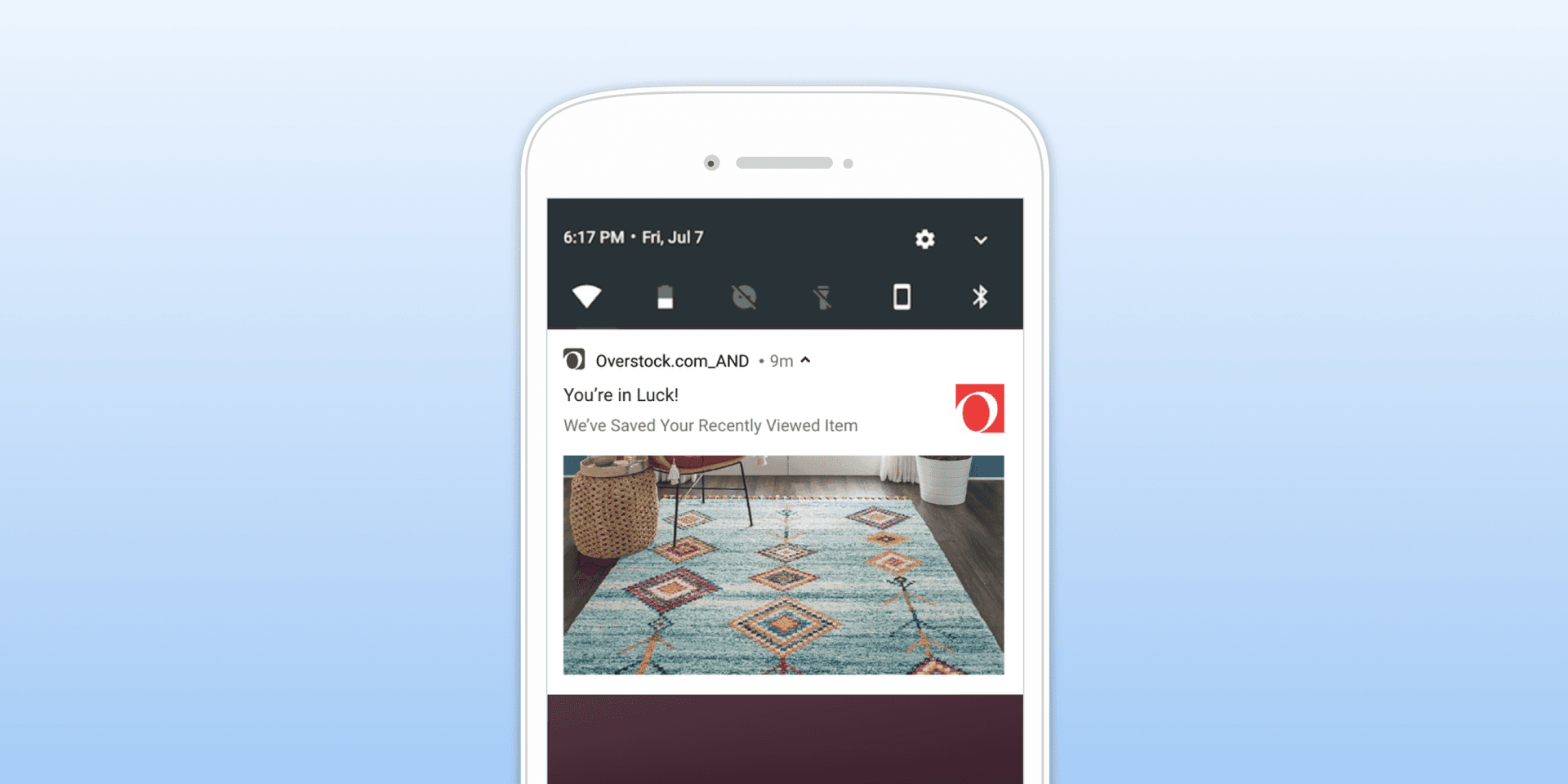
Leading online retailer Overstock was able to take advantage of this powerful flexibility in order to power automated messaging throughout the customer lifecycle, ensuring users were receiving timely messages that were personalized with highly relevant content that could support stronger business outcomes. Using Connected Content, Overstock was able to automatically trigger and personalize responsive messages in the moment to highlight products that recipients had recently viewed but not purchased—and then leverage the Braze platform’s cross-channel orchestration capabilities to trigger a push notification that would alert email recipients that Overstock had saved a recently-viewed item of theirs and nudge them to close the deal.
The upshot? While Connected Content is capable of supporting simple personalization use cases, the feature’s ability to connect with internal and external systems is where it really shines. That functionality allows Connected Content to support significant flexibility on the part of marketers when it comes to using data, copy, visuals, and other potential content to inform, enrich, and even trigger rich experiences across channels and platforms.
API Campaigns and API-Triggered Campaigns
For most situations, marketers may find that building, triggering, and sending their campaigns entirely within Braze is an easy, effective way to reach their customers with personalized, cross-channel messaging outreach. However, sometimes brands need the flexibility and granular control to manage their customer messaging in a different way, requiring them to think outside the box and find innovative ways to use their marketing technologies. Braze helps to make that extensibility possible in part through our support for API campaigns and API-triggered campaigns.
API Campaigns
Like comedy, effective customer engagement requires thoughtful timing. After all, even ideal messages won’t land with customers if they arrive at an inconvenient or awkward time. (Think welcome emails sent to longtime customers or abandoned cart notifications that arrive after purchase, for example.) API-triggered campaigns powered by Braze make it possible for marketers to build out rich, personalized cross-channel flows within the Braze platform, but to trigger the delivery of the associated messages via API, allowing people beyond the marketing team or signals within your company’s own internal systems to determine when a specific message should be sent.
The flexibility this provides can be significant. One Braze customer, a leading news organization, used API-triggered campaigns to support swift, timely notifications in connection with the 2016 US federal election. Rather than waiting for their decision desk to make the call on a given race, then having to frantically try to write up a message to send to their users in the moment, the organization was able to pre-build push notifications based on a range of different potential outcomes for each race. Then, when the decision desk made a determination, all they had to do was tap the appropriate button in front of them; that system would both publish their news articles while simultaneously communicating with the Braze platform via API to trigger the correct push variant, ensuring the fastest-possible delivery of this breaking news.
API Campaigns
API campaigns are sent by the Braze platform, but, unlike API-triggered campaigns, the content and scheduling for these campaigns are handled outside of Braze (for instance, within a bespoke in-house system). That allows companies to extend their message creation process outside of the Braze platform while still being able to take advantage of our native cross-channel support, leverage our personalization capabilities, and to track the impact of these campaigns alongside messages that were built and sent inside of Braze.
What does that look like in practice? One company used this functionality to build push notifications related to late-breaking sports news within their content management system (CMS) and then swiftly send those messages via Braze, leveraging our platform’s dynamic segmentation capabilities in the process to more accurately target the messages to the right recipients.
Feature Flags
Consumers today expect cohesive brand experiences across all the different digital platforms and channels they engage on—and that means that sometimes these experiences need to be able to extend beyond the messages you send. To provide that reach and the flexibility required to make these cohesive experiences possible, Braze recently launched Feature Flags in beta.
This simple but powerful feature allows brands to seamlessly enable or disable product functionality in connection with their mobile app or website for a given selection of users, allowing them to—for instance—surface one product experience for individuals who received a promotional email and a different experience for users who didn’t. Imagine a brand that recently built out a loyalty program section of its mobile app, but only wants that part of the app visible to individuals who have been identified as high-value users; with Braze, the company could build out a messaging flow that not only tells message recipients about the new program, it also uses Feature Flags to “turn on” access to that part of app in tandem with receipt of the outreach, creating a seamless experience that extends beyond the message into the product.
Final Thoughts
The customer engagement landscape keeps changing and marketers need to change with it to stay competitive. Sometimes that means developing new marketing strategies and tactics to more successfully engage your audience—and sometimes it means leveraging the flexibility of your customer engagement platform to support innovative, complex, or uncommon use cases. Choosing a customer engagement solution that embraces extensibility when it comes to digital messaging makes it easier to meet those needs effectively, scalably, and sustainably, no matter what comes next.
Interested in learning more about how to support your organization’s customer engagement efforts? Check out our exclusive on demand webinar, “Activating Your Customer Data.”
Related Tags
Be Absolutely Engaging.™
Sign up for regular updates from Braze.
Related Content
View the Blog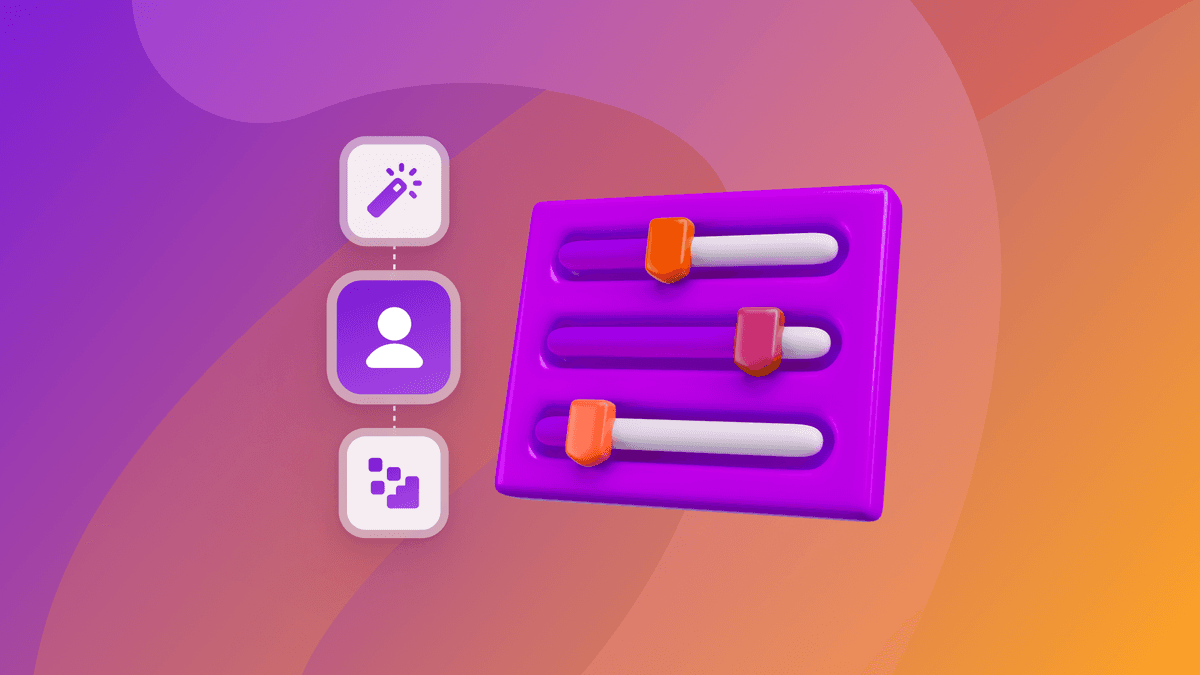
How behavioral marketing turns data into personalized experiences

Team Braze

How Braze supports exceptional customer engagement during Black Friday, Cyber Monday, and beyond

Todd Grennan
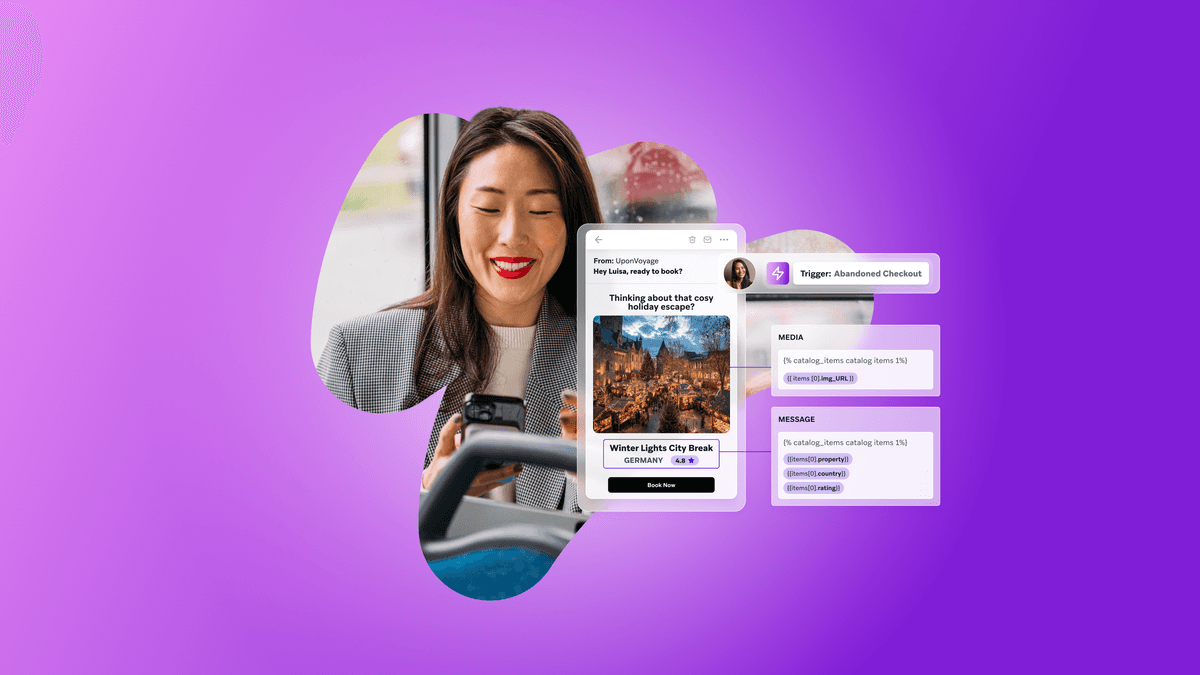
How to overcome messaging fatigue this holiday season
